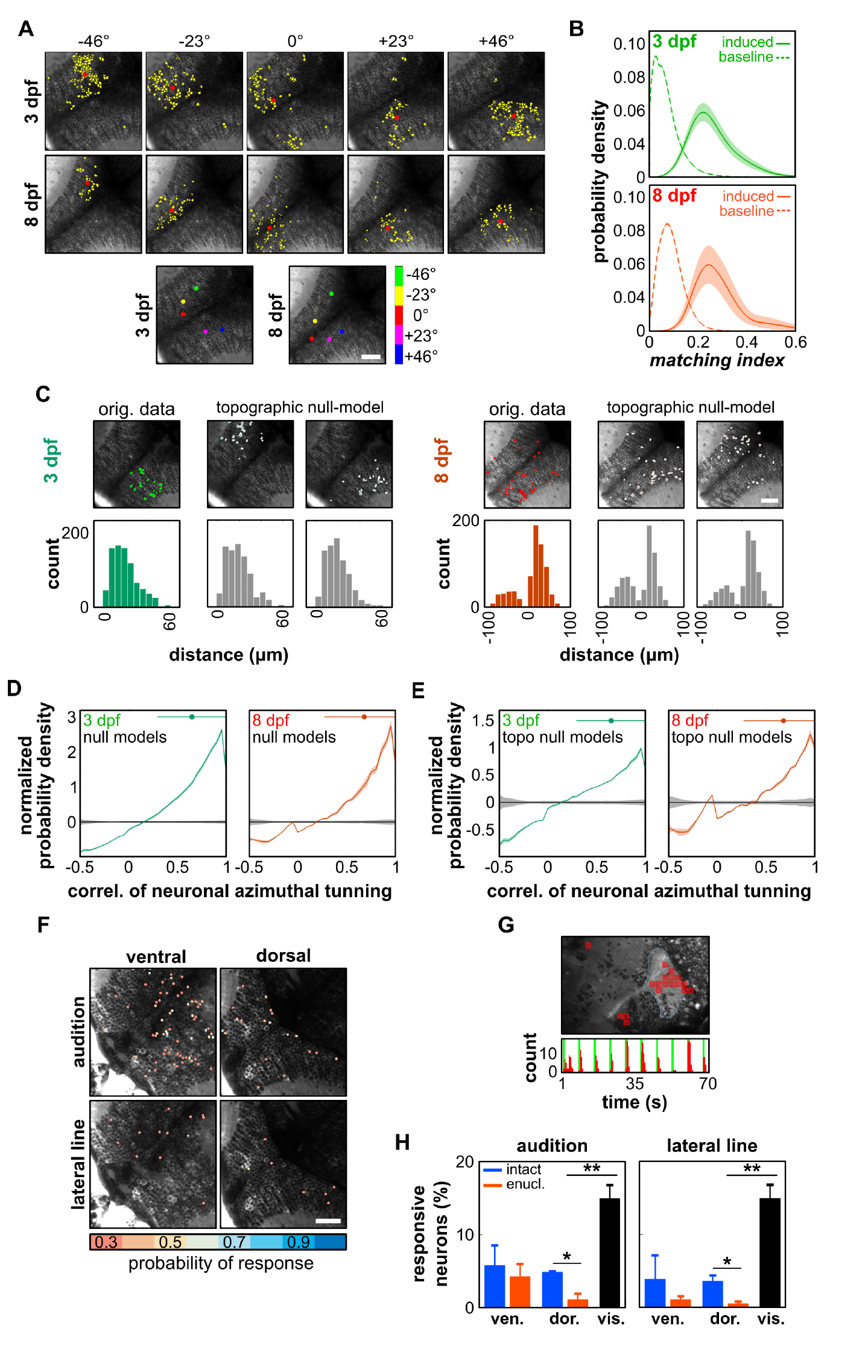Fig. S3
Spontaneous neuronal assemblies regroup functionally related neurons, related to Figure 2.
(A) Examples of neuronal assemblies induced by light-spots of 20° angular size, across the visual field (from -46° to +46°) at 3 and 8 dpf; the center of mass of each visually induced assembly is indicated by a red dot; these dots are color-coded in the bottom panels according to the position of the visual stimulus that induced the response. Note the match between the order of the colors along the caudo-rostral axis and the colors representing the different positions of stimulation, indicating that the tectal retinotopic map is organized along the tectal caudo-rostral axis.
(B) Probability density distributions of the MIs of the significant visually induced neuronal groups (3 dpf: green; 8 dpf: red), during the periods of spontaneous activity. The dashed curves represent the distribution of the non-significant MI values (baselines). Note that distributions and magnitudes of induced assemblies were comparable at 3 and 8 dpf: the probability density peaks of the significant matching index were 0.226 ± 0.013 at 3 dpf and 0.254 ± 0.013 at 8 dpf, while the ones of their respective baseline were 0.047 ± 0.006 (p < 10-5 by comparing MIs and baselines) and 0.067 ± 0.004 (p < 10-4).
(C) Examples of 3 dpf (left panels) and 8 dpf (right panels) spontaneous assemblies and corresponding two topographic null assemblies (out of 50). Notice that the distributions of the distance between pair of neurons in the assembly and their respective null model assemblies are similar (bottom panels); positive and negative distance correspond to intra- and interhemisphere neuronal pairs, respectively.
(D) Distribution of the normalized probability density of the pooled pair-wise correlation coefficients of the spatial tuning curves (azimuth tuning curves) of neurons belonging to spontaneous assemblies at 3 (green) and 8 dpf (red) and their respective null models (black). For the normalization, the distributions were divided by the null-model distributions. Note the large bias of the spontaneous assemblies toward grouping neurons with highly similar tuning curves, both at 3 and 8 dpf. The confidence intervals were calculated with a Jack-Knife procedure, across experiments. The significant bias range and median are indicated by the top line and the dot, respectively. The bias ranges became significant above 0.32 ± 0.01 and 0.26 ± 0.08, with medians of 0.633 ± 0.004 and 0.642 ± 0.003, for 3 and 8 dpf larvae respectively (the medians between stages were not statistically different: p = 0.116).
(E). Same as D, but the normalization was performed using the distribution of the topographic null-models. Remarkably, the original assemblies still had a significant bias toward neurons with similar tunings, despite the preservation of the distribution of pair-wise distances in these topographic null-models.
(F) Examples of topographic localization of the neurons responding to at least 25% of the auditory (top panels) or lateral line stimuli (bottom panels) in a ventral (left panels) and a dorsal (right panels) layer of the optic tectum. The scale bar indicates the probability of response (resp.) of the neurons to at least 25% of the stimuli.
(G) To test whether the weak tectal response to lateral line stimuli is a direct consequence of lateral line stimulation failure, we monitored the response in the torus semicircularis (TS, its neuropil is outlined by a pale dashed blue line). Regions of interest (ROIs, delineated out of a homogeneous 10 x 10 pixels grid) in red show the TS regions responding to at least 25 % of the stimuli. The histogram of the significant Ca2+ events of the ROIs show a reliable and strong response to lateral line stimuli in the TS. (H) Proportion of neurons responding to at least 25 % of the auditory (left panel) and lateral line (right panel) stimuli, in intact (n = 3, blue) and enucleated larvae (n = 3, red). The proportion of responsive neurons to visual stimulation (vis., moving bar across the visual field) in the dorsal layer of the optic tectum (n = 13, black). Note the significant large differences of the visual responses with respect to the auditory and lateral line ones (p < 0.005). In the ventral layers (vent.) of the optic tectum, we observed no significant differences between intact and enucleated larvae for auditory and lateral line responses (p > 0.97). In the dorsal layers (dor.), the proportion of cells responding to the stimulation tends however to be smaller in the enucleated than in the intact larvae (p < 0.04). Error bars: SEM.

